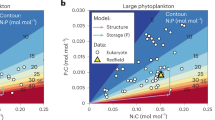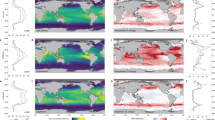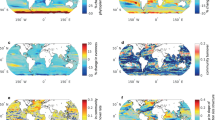Abstract
Ocean phytoplankton biomass is predicted to decline in Earth system models, due in large part to an expansion of nutrient-deplete ocean regions. However, the representation of ecosystems in these models is simplified and based on only a few functional types. As a result, they fail to capture the high diversity known to exist within and across phytoplankton communities. Here we present an assessment of the global biogeography of the very abundant but little studied picoeukaryotic phytoplankton by analysing a global abundance dataset with a neural-network-derived quantitative niche model. Combining this niche model with previous assessments of the distribution of Prochlorococcus and Synechococcus, we find that different cell sizes among picophytoplankton lineages are clearly partitioned into latitudinal niches. In addition, picophytoplankton biomass increases along a temperature gradient in low-latitude regions. We infer that future warmer ocean conditions can lead to elevated phytoplankton biomass in regions that are already dominated by picophytoplankton. Finally, we demonstrate that elevated upper-ocean nutrient recycling and lower nutrient requirements of phytoplankton have the potential to support increasing low-latitude phytoplankton biomass with future warming.
This is a preview of subscription content, access via your institution
Access options
Access Nature and 54 other Nature Portfolio journals
Get Nature+, our best-value online-access subscription
$29.99 / 30 days
cancel any time
Subscribe to this journal
Receive 12 print issues and online access
$259.00 per year
only $21.58 per issue
Buy this article
- Purchase on Springer Link
- Instant access to full article PDF
Prices may be subject to local taxes which are calculated during checkout





Similar content being viewed by others
Data availability
All observations and phytoplankton model data are available at BCO-DMO (https://www.bco-dmo.org/project/764270). The biogeochemical model data are available here (https://zenodo.org/record/3543774).
Code availability
The biogeochemical model code is available at https://doi.org/10.5281/zenodo.3543779.
References
Hoegh-Guldberg, O. & Bruno, J. F. The impact of climate change on the world’s marine ecosystems. Science 328, 1523–1528 (2010).
Moore, J. K. et al. Sustained climate warming drives declining marine biological productivity. Science 359, 1139–1143 (2018).
Bopp, L. et al. Multiple stressors of ocean ecosystems in the 21st century: projections with CMIP5 models. Biogeosciences 10, 6225–6245 (2013).
Cabre, A., Marinov, I. & Leung, S. Consistent global responses of marine ecosystems to future climate change across the IPCC AR5 Earth system models. Clim. Dyn. 45, 1253–1280 (2015).
Graff, J. R. et al. Photoacclimation of natural phytoplankton communities. Mar. Ecol. Prog. Ser. 542, 51–62 (2016).
McQuatters-Gollop, A. et al. Is there a decline in marine phytoplankton? Nature 472, E6–E7 (2011).
Quéré, C. Le et al. Ecosystem dynamics based on plankton functional types for global ocean biogeochemistry models. Glob. Change Biol. 11, 2016–2040 (2005).
Lomas, M. W., Bonachela, J. A., Levin, S. A. & Martiny, A. C. Impact of ocean phytoplankton diversity on phosphate uptake. Proc. Natl Acad. Sci. USA 111, 17540–17545 (2014).
Rusch, D. B. et al. The sorcerer II global ocean sampling expedition: northwest Atlantic through eastern tropical Pacific. PLoS Biol. 5, e77 (2007).
Flombaum, P. et al. Present and future global distributions of the marine cyanobacteria Prochlorococcus and Synechococcus. Proc. Natl Acad. Sci. USA 110, 9824–9829 (2013).
Irwin, A. J., Finkel, Z. V., Müller-Karger, F. E. & Troccoli Ghinaglia, L. Phytoplankton adapt to changing ocean environments. Proc. Natl Acad. Sci. USA 112, 5762–5766 (2015).
Larkin, A. A. & Martiny, A. C. Microdiversity shapes the traits, niche space, and biogeography of microbial taxa. Environ. Microbiol. Rep. 9, 55–70 (2017).
Irwin, A. J., Nelles, A. M. & Finkel, Z. V. Phytoplankton niches estimated from field data. Limnol. Oceanogr. 57, 787–797 (2012).
Colwell, R. K. & Rangel, T. F. Hutchinson’s duality: the once and future niche. Proc. Natl Acad. Sci. USA 106, 19651–19658 (2009).
Moon-van der Staay, S. Y., De Wachter, R. & Vaulot, D. Oceanic 18S rDNA sequences from picoplankton reveal unsuspected eukaryotic diversity. Nature 409, 607–610 (2001).
Li, W. K. W. From cytometry to macroecology: a quarter century quest in microbial oceanography. Aquat. Microb. Ecol. 57, 239–251 (2009).
Morán, X. A. G., López-Urrutia, Á., Calvo-Díaz, A. & LI, W. K. W. Increasing importance of small phytoplankton in a warmer ocean. Glob. Change Biol. 16, 1137–1144 (2010).
Bienfang, P. K., Szyper, J. P., Okamoto, M. Y. & Noda, E. K. Temporal and spatial variability of phytoplankton in a subtropical environment. Limnol. Oceanogr. 29, 527–539 (1984).
Landry, M. R., Kirshtein, J. & Constantinou, J. Abundances and distributions of picoplankton populations in the central equatorial Pacific from 12° N to 12° S, 140° W. Deep. Sea Res. Part 2 Top. Stud. Oceanogr. 43, 871–890 (1996).
Rodríguez, F. et al. Ecotype diversity in the marine picoeukaryote Ostreococcus (Chlorophyta, Prasinophyceae). Environ. Microbiol. 7, 853–859 (2005).
Six, C. et al. Contrasting photoacclimation costs in ecotypes of the marine eukaryotic picoplankter. Ostreococcus. Limnol. Oceanogr. 53, 255–265 (2008).
Moore, L. R., Goericke, R. & Chisholm, S. W. Comparative physiology of Synechococcus and Prochlorococcus: influence of light and temperature on growth, pigments, fluorescence and absorptive properties. Mar. Ecol. Prog. Ser. 116, 259–275 (1995).
Kulk, G., De Vries, P., Van De Poll, W. H., Visser, R. J. W. & Buma, A. G. J. Temperature-dependent growth and photophysiology of prokaryotic and eukaryotic oceanic picophytoplankton. Mar. Ecol. Prog. Ser. 466, 43–55 (2012).
Buitenhuis, E. T. et al. Picophytoplankton biomass distribution in the global ocean. Earth Syst. Sci. Data 4, 37–46 (2012).
Rivkin, R. B. & Legendre, L. Biogenic carbon cycling in the upper ocean: effects of microbial respiration. Science 291, 2398–2400 (2001).
Rafter, P. A., Sigman, D. M. & Mackey, K. R. M. Recycled iron fuels new production in the eastern equatorial Pacific Ocean. Nat. Commun. 8, 1100 (2017).
White, A. E., Watkins-Brandt, K. S., Engle, M. A., Burkhardt, B. & Paytan, A. Characterization of the rate and temperature sensitivities of bacterial remineralization of dissolved organic phosphorus compounds by natural populations. Front. Microbiol. 3, 276 (2012).
Martiny, A. C. et al. Strong latitudinal patterns in the elemental ratios of marine plankton and organic matter. Nat. Geosci. 6, 279–283 (2013).
Martiny, A. C., Vrugt, J. A., Primeau, F. W. & Lomas, M. W. Regional variation in the particulate organic carbon to nitrogen ratio in the surface ocean. Global Biogeochem. Cycles 27, 723–731 (2013).
Chen, B., Landry, M. R., Huang, B. & Liu, H. Does warming enhance the effect of microzooplankton grazing on marine phytoplankton in the ocean? Limnol. Oceanogr. 57, 519–526 (2012).
Moreno, A. R. & Martiny, A. C. Ecological stoichiometry of ocean plankton. Ann. Rev. Mar. Sci. 10, 43–69 (2018).
Morel, A. et al. Examining the consistency of products derived from various ocean color sensors in open ocean (Case 1) waters in the perspective of a multi-sensor approach. Remote Sens. Environ. 111, 69–88 (2007).
Casey, J. R., Aucan, J. P., Goldberg, S. R. & Lomas, M. W. Changes in partitioning of carbon amongst photosynthetic pico- and nano-plankton groups in the Sargasso Sea in response to changes in the North Atlantic Oscillation. Deep. Sea Res. Part 2 Top. Stud. Oceanogr. 93, 58–70 (2013).
Dunne, J. P. et al. GFDL’s ESM2 global coupled climate–carbon Earth system models. Part II: carbon system formulation and baseline simulation characteristics. J. Clim. 26, 2247–2267 (2013).
Taylor, K. E., Stouffer, R. J. & Meehl, G. A. An overview of CMIP5 and the experiment design. Bull. Am. Meteorol. Soc. 93, 485–498 (2012).
Pearman, P. B., Guisan, A., Broennimann, O. & Randin, C. F. Niche dynamics in space and time. Trends Ecol. Evol. 23, 149–158 (2008).
DeVries, T. & Primeau, F. Dynamically and observationally constrained estimates of water-mass distributions and ages in the global ocean. J. Phys. Oceanogr. 41, 2381–2401 (2011).
Primeau, F. W., Holzer, M. & DeVries, T. Southern ocean nutrient trapping and the efficiency of the biological pump. J. Geophys. Res. Ocean. 118, 2547–2564 (2013).
Teng, Y.-C., Primeau, F. W., Moore, J. K., Lomas, M. W. & Martiny, A. C. Global-scale variations of the ratios of carbon to phosphorus in exported marine organic matter. Nat. Geosci. 7, 895–898 (2014).
Galbraith, E. D. & Martiny, A. C. A simple nutrient-dependence mechanism for predicting the stoichiometry of marine ecosystems. Proc. Natl Acad. Sci. USA 112, 8199–8204 (2015).
Yvon-Durocher, G., Dossena, M., Trimmer, M., Woodward, G. & Allen, A. P. Temperature and the biogeography of algal stoichiometry. Glob. Ecol. Biogeogr. 24, 562–570 (2015).
Acknowledgements
We thank the many contributing researchers for the oceanographic data and K. Mackey and J. Martiny at UCI for helpful comments. Financial support for this work was provided by the National Science Foundation (OCE-1046297 and OCE-1848576 to A.C.M.), CONICET, UBACYT (20020170100620BA), Agencia Nacional de Promoción Científica y Tecnológica (PICT-2017-3020 to P.F.) and US Department of Energy Office of Biological and Environmental Research (DE-SC0012550 to F.W.P.).
Author information
Authors and Affiliations
Contributions
P.F. and A.C.M. designed the study, P.F., W.-L.W. and F.W.P. did the analysis and A.C.M. wrote the paper.
Corresponding author
Ethics declarations
Competing interests
The authors declare no competing interests.
Additional information
Peer review information Primary handling editors: Xujia Jiang; Heike Langenberg.
Publisher’s note Springer Nature remains neutral with regard to jurisdictional claims in published maps and institutional affiliations.
Extended data
Extended Data Fig. 1
Conceptual model for linking ecotype diversity, environmental, and biotic factors to the fundamental and realized niches of phytoplankton lineages.
Extended Data Fig. 2
Global distribution of sampling sites for the 13,771 observations used in this study.
Extended Data Fig. 3 Scatter density for observed versus predicted picoeukaryotic phytoplankton cell abundance.
Cell abundances were predicted based on ancillary environmental information associated with each observation. The dashed line represents the 1:1 relationship.
Extended Data Fig. 4 Predicted seasonal distributions of picoeukaryotic phytoplankton at the surface.
Mean quarterly surface picoeukaryotic phytoplankton abundance for (a) January to March, (b) April to June, (c) July to September, and (d) October to December.
Extended Data Fig. 5 Predicted picoeukaryotic phytoplankton cell abundance and number of observations for the combination of temperature and (a) nitrate, and (b) photosynthetic active radiation (PAR).
The predicted abundance represents the mean quantitative niche model output based on 100 trained neural networks at constant (a) PAR (3.2 E m−2 d−1) and (b) nitrate (3.2 µM). Circle size represents the number of observations on a gridded combination of environmental variables.
Extended Data Fig. 6 Distribution of total picophytoplankton carbon biomass and relative contribution of each lineage at the ocean surface.
Proportional contribution to total picophytoplankton carbon biomass by (a) picoeukaryotic phytoplankton, (b) Synechococcus and (c) Prochlorococcus. (d) Total picophytoplankton carbon biomass. (e) Proportional contribution of picophytoplankton to total phytoplankton carbon biomass. Total picophytoplankton carbon biomass was estimated as the sum of picoeukaryotes, Synechococcus and Prochlorococcus cellular abundance weighted by their cellular carbon biomass. Total phytoplankton biomass was predicted by the GFDL ES2M model.
Extended Data Fig. 7 Projected impact of climate change on total picophytoplankton carbon biomass.
Proportional area in the 30˚N-30˚S band accounted for by (a) total picophytoplankton biomass concentration for the historic and RCP8.5 CMIP5 scenarios, and (b) changes in biomass between RCP8.5 and historic CMIP5. (c) Percentage of change in surface total picophytoplankton carbon biomass estimated for the end of 21st and 20th centuries based on temperature and nitrate concentration simulated under the RCP8.5 and historic CMIP5 scenarios.
Extended Data Fig. 8 Design of a simple model describing the relationship between nutrient cycling and standing stock of phytoplankton biomass.
Fluxes are identified by arrows and stocks by boxes. N and Nd represent nutrient concentration at the euphotic and deep layer respectively, and P represents phytoplankton biomass. k represents phytoplankton remineralization rate, u the phytoplankton nutrient uptake rate, s the phytoplankton sinking rate, and q the vertical mixing rate.
Extended Data Fig. 9 Sensitivity of global picophytoplankton biomass to changes in remineralization rates estimated with an ocean biogeochemical model.
b is the exponential decay of particulate organic matter in the water column following a power law Martin curve that represents nutrient trapping, and κd is the remineralization rate of DOP to DIP. Global biomass for the control used values in Table S2.
Extended Data Fig. 10 Availability of observations to inform future environmental conditions.
Number of observations and percent of ocean volume for the RCP8.5 in a combination of temperature and nitrate.
Supplementary information
Supplementary Information
Supplementary Tables 1 and 2.
Rights and permissions
About this article
Cite this article
Flombaum, P., Wang, WL., Primeau, F.W. et al. Global picophytoplankton niche partitioning predicts overall positive response to ocean warming. Nat. Geosci. 13, 116–120 (2020). https://doi.org/10.1038/s41561-019-0524-2
Received:
Accepted:
Published:
Issue Date:
DOI: https://doi.org/10.1038/s41561-019-0524-2
This article is cited by
-
Nutrient availability regulates the microbial biomass structure in marine oligotrophic waters
Hydrobiologia (2024)
-
Climate-driven zooplankton shifts cause large-scale declines in food quality for fish
Nature Climate Change (2023)
-
Chemotaxis increases metabolic exchanges between marine picophytoplankton and heterotrophic bacteria
Nature Microbiology (2023)
-
Understanding opposing predictions of Prochlorococcus in a changing climate
Nature Communications (2023)
-
Cryptic diversity, niche displacement and our poor understanding of taxonomy and ecology of aquatic microorganisms
Hydrobiologia (2023)



